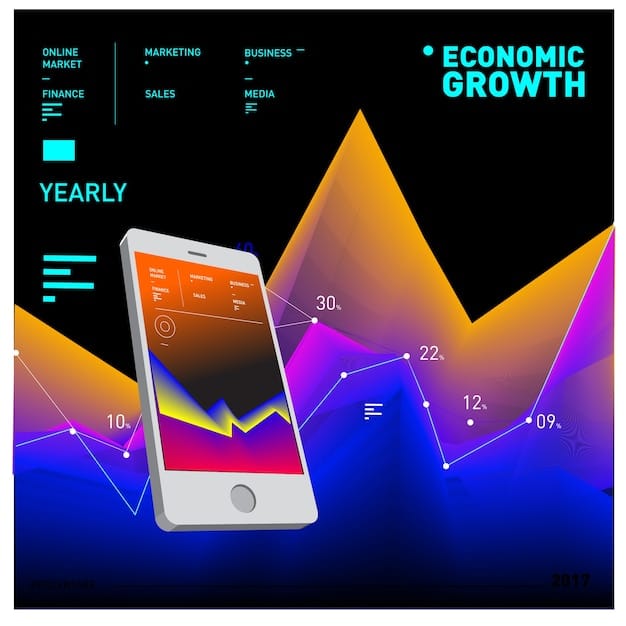E-commerce Startup Funding: Finding the Next 10x Opportunity

E-commerce startup funding is crucial for growth, and identifying the next 10x opportunity involves evaluating market trends, assessing team capabilities, and understanding the competitive e-commerce landscape to secure necessary capital.
Navigating the world of e-commerce startup funding: how to identify the next 10x opportunity can feel like searching for a needle in a haystack. What are the key indicators investors look for in e-commerce ventures poised for exponential growth?
Understanding the E-commerce Startup Landscape
To effectively identify a 10x opportunity in e-commerce, it’s crucial to first understand the current landscape. This includes recognizing the challenges and opportunities that startups face in this dynamic sector.
Key Challenges for E-commerce Startups
E-commerce startups often face several hurdles. Competition is fierce, and customer acquisition costs can be high.
- High Customer Acquisition Costs: Marketing and advertising expenses can quickly deplete a startup’s budget.
- Intense Competition: The e-commerce market is crowded, making it difficult to stand out.
- Logistics and Fulfillment: Managing inventory, shipping, and returns can be complex and costly.
Emerging Opportunities in E-commerce
Despite the challenges, significant opportunities exist for e-commerce startups. Innovative business models and technological advancements are creating new avenues for growth.
- Niche Markets: Focusing on a specific niche can reduce competition and attract loyal customers.
- Personalization: Using data to personalize the shopping experience can increase conversion rates.
- Sustainable Practices: Consumers are increasingly interested in environmentally friendly products and businesses.
By understanding these challenges and opportunities, investors and entrepreneurs can better assess the potential of e-commerce startups. This knowledge forms the foundation for identifying ventures with the potential for 10x growth.
Analyzing Market Trends and Consumer Behavior
Identifying the next 10x opportunity in e-commerce requires a keen understanding of market trends and consumer behavior. These insights can reveal unmet needs and emerging demands.
Identifying Relevant Market Trends
Staying ahead of market trends is essential. This involves monitoring industry reports, analyzing competitor activities, and tracking technological advancements.
- Mobile Commerce: With the increasing use of smartphones, mobile commerce continues to grow.
- Social Commerce: Platforms like Instagram and TikTok are becoming major sales channels.
- Artificial Intelligence: AI-powered tools are enhancing personalization and customer service.
Understanding Consumer Preferences
Understanding what consumers want and how they behave is crucial. This can be achieved through market research and data analysis.

Analyzing consumer behavior involves studying:
- Purchase Patterns: Understanding when and why consumers buy certain products.
- Customer Feedback: Collecting and analyzing reviews and feedback to improve products and services.
- Demographic Data: Tailoring offerings to specific demographics.
By carefully analyzing market trends and consumer behavior, you can identify potential gaps in the market and create e-commerce solutions that resonate with consumers.
Assessing the Team and Business Model
Beyond market analysis, assessing the team and business model is vital. A strong team and a viable business model are essential for achieving 10x growth.
Evaluating the Management Team
The quality of the management team can make or break a startup. Investors look for teams with experience, expertise, and a proven track record.
- Experience: Has the team successfully launched and scaled businesses before?
- Expertise: Does the team have the necessary skills in areas like marketing, technology, and finance?
- Vision: Does the team have a clear vision for the future of the business?
Validating the Business Model
The business model should be sustainable and scalable. It should address a real market need and generate revenue efficiently.
A strong business model includes:
- Value Proposition: A clear statement of the value the business provides to customers.
- Revenue Model: A plan for generating revenue, such as subscription fees or transaction fees.
- Scalability: The ability to grow the business without significantly increasing costs.
A well-thought-out business model, coupled with a capable team, increases the likelihood of achieving significant growth and attracting further e-commerce startup funding: how to identify the next 10x opportunity.
Analyzing Financial Projections and Metrics
Financial projections and key metrics provide insights into the financial health and growth potential of an e-commerce startup. Understanding these aspects is critical for making informed investment decisions.
Reviewing Financial Projections
Financial projections should be realistic and based on solid assumptions. They should include:
- Revenue Forecasts: Projections of future sales based on market analysis and growth strategies.
- Expense Budgets: Detailed budgets for operating expenses, marketing costs, and capital expenditures.
- Cash Flow Statements: Projections of cash inflows and outflows to ensure the business can meet its financial obligations.
Key Performance Indicators (KPIs)
Monitoring KPIs helps track performance and identify areas for improvement.

Important KPIs include:
- Customer Acquisition Cost (CAC): The cost of acquiring a new customer.
- Conversion Rate: The percentage of website visitors who make a purchase.
- Average Order Value (AOV): The average amount spent per order.
- Customer Lifetime Value (CLTV): The total revenue a customer is expected to generate over their relationship with the business.
By analyzing financial projections and monitoring KPIs, you can gain a deeper understanding of an e-commerce startup’s financial viability and growth prospects.
Assessing Competitive Advantage and Differentiation
In a crowded e-commerce market, having a strong competitive advantage is essential for success. This involves understanding what sets a startup apart from its competitors.
Identifying Unique Selling Propositions (USPs)
A USP is what makes a business unique and attractive to customers. It could be a unique product, a superior customer experience, or a lower price.
Examples of USPs include:
- Proprietary Technology: A unique technology that provides a competitive edge.
- Exceptional Customer Service: A commitment to providing outstanding customer support.
- Innovative Products: Products that offer unique features or solve a specific problem.
Analyzing the Competitive Landscape
Understanding the competitive landscape involves identifying key competitors and analyzing their strengths and weaknesses.
This analysis should include:
- Market Share: Who are the leading players in the market?
- Pricing Strategies: How do competitors price their products?
- Marketing Tactics: What marketing strategies are competitors using?
By assessing competitive advantage and differentiation, you can determine whether an e-commerce startup has the potential to stand out and capture market share.
Using Technology and Innovation as a Key Driver
Technology and innovation play a crucial role in driving growth in the e-commerce sector. Startups that leverage technology effectively are more likely to achieve 10x growth.
Leveraging Emerging Technologies
Adopting emerging technologies can provide a significant competitive advantage. This includes technologies like:
- Artificial Intelligence (AI): AI can enhance personalization, improve customer service, and automate tasks.
- Augmented Reality (AR): AR can create immersive shopping experiences.
- Blockchain: Blockchain can improve supply chain transparency and security.
Creating Innovative Solutions
Innovation is essential for creating new value and attracting customers. This could involve developing new products, improving processes, or enhancing the customer experience.
Examples of innovative solutions include:
- Subscription Boxes: Curated collections of products delivered regularly to customers.
- Personalized Recommendations: AI-powered recommendations based on customer preferences.
- Sustainable Packaging: Environmentally friendly packaging that reduces waste.
By embracing technology and fostering innovation, e-commerce startups can create a competitive edge and achieve significant growth. Understanding how to leverage these elements is key to e-commerce startup funding: how to identify the next 10x opportunity.
| Key Aspect | Brief Description |
|---|---|
| 📈 Market Trends | Analyze trends like mobile commerce and AI to spot opportunities. |
| 🤝 Team Quality | Assess the team’s experience, expertise, and vision. |
| 💰 Financials | Review financial projections, KPIs like CAC, and CLTV. |
| 🚀 Innovation | Look for startups leveraging AI, AR, and blockchain. |
FAQ
A 10x opportunity refers to an e-commerce startup with the potential for exponential growth, typically indicating the possibility of achieving ten times the initial investment or revenue. This involves innovative solutions, scalability, and market disruption.
Assess market potential by analyzing market size, growth rate, and trends. Identify target customers and their needs. Evaluate competition and potential barriers to entry. Market research and data are key.
Key financial metrics include Customer Acquisition Cost (CAC), Conversion Rate, Average Order Value (AOV), and Customer Lifetime Value (CLTV). Review revenue forecasts, expense budgets, and cash flow statements for financial viability.
The team is crucial. Look for experience, expertise, and a proven track record. A capable team can adapt to challenges and execute effectively. Their vision drives the company forward.
Technology is vital for driving growth. Startups that leverage AI, AR, and blockchain can improve personalization, customer service, and supply chain transparency. Innovation is key to creating a competitive edge.
Conclusion
Identifying the next 10x opportunity in e-commerce requires a multifaceted approach that combines market analysis, team assessment, financial review, and technological insight. By carefully evaluating these aspects, investors and entrepreneurs can increase their chances of success in this dynamic and competitive landscape. Staying informed about market trends and consumer behavior is paramount for spotting ventures with true potential.





